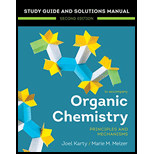
Concept explainers
(a)
Interpretation:
The Lewis structure for an aldetetrose is to be drawn.
Concept introduction:
Monosaccharides are called simple sugars, with the number of oxygen atoms same as the number of carbon atoms. The general formula for monosaccharides is
Answer to Problem 4.25P
The Lewis structure for an aldetetrose is
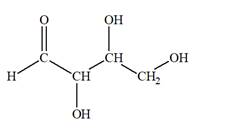
Explanation of Solution
Aldotetrose is a mono-saccharide. The name “aldo” indicates that the carbonyl group must be present at the terminal carbon atom, while the word “tetrose” indicates a chain of four carbon atoms. Thus, aldotetrose is a sugar having an
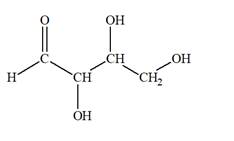
The molecular formula for the above structure is
Altetrose is a mono-saccharide having a carbonyl group at the terminal carbon atom, and its molecular formula is
(b)
Interpretation:
The Lewis structure for a ketotetrose is to be drawn.
Concept introduction:
Monosaccharides are called simple sugars, with the number of oxygen atoms same as the number of carbon atoms. The general formula for a monosaccharide is
Answer to Problem 4.25P
The Lewis structure for a ketotetrose is
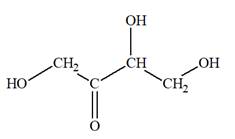
Explanation of Solution
Ketotetrose is a type of mono-saccharide. The name “keto” indicates that the carbonyl group must be present at the internal carbon atom, while the word “tetrose” indicates the chain of four carbon atoms. Thus, ketotetrose is a sugar having a carbonyl group at the internal carbon atom, and the structure must have four carbon atoms. The general molecular formula for mono-saccharides is
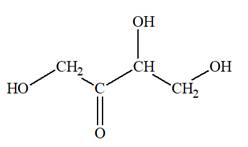
The molecular formula for the above structure is
Ketotetrose is a mono-saccharide having a carbonyl group at the internal carbon atom, and its molecular formula is
(c)
Interpretation:
The Lewis structure for an aldetriose is to be drawn.
Concept introduction:
Monosaccharides are called simple sugars, with the number of oxygen atoms same as the number of carbon atoms. Thus, the general molecular formula for a monosaccharide is
Answer to Problem 4.25P
The Lewis structure for an aldetriose is
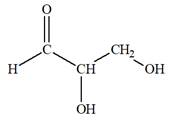
Explanation of Solution
Aldotriose is a type of mono-saccharide. The name “aldo”’ indicates that the carbonyl group must be present at the terminal carbon atom, while the word “triose” indicates a chain of three carbon atoms. Thus, aldotriose is a sugar having an aldehyde group at the terminal carbon atom, and the structure must have three carbon chain. The general molecular formula for mono-saccharides is

The molecular formula for the above structure is
Altetrose is a mono-saccharide having a carbonyl group at the terminal carbon atom, and its molecular formula is
(d)
Interpretation:
The Lewis structure for a ketotriose is to be drawn.
Concept introduction:
Monosaccharides are called simple sugars, with the number of oxygen atoms same as the number of carbon atoms. Thus, the general molecular formula for a monosaccharide is
Answer to Problem 4.25P
The Lewis structure for a ketotriose is
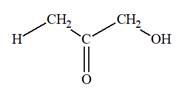
Explanation of Solution
Ketotriose is a type of mono-saccharide. The name “keto” indicates that the carbonyl group must be present at the internal carbon atom, while the word “tetrose” indicates the chain of four carbon atoms. Thus, ketotriose is a sugar having a carbonyl group at the internal carbon atom, and the structure must have three carbon atoms. The general molecular formula for mono-saccharides is

The molecular formula for the above structure is
Ketotetrose is a mono-saccharide having a carbonyl group at the internal carbon atom, and its molecular formula is
(e)
Interpretation:
The Lewis structure for a ketohexose, which is different from fructose, is to be drawn.
Concept introduction:
Monosaccharides are called simple sugars, with the number of oxygen atoms same as the number of carbon atoms. Thus, the general molecular formula for a monosaccharide is
Answer to Problem 4.25P
The Lewis structure for a ketohexose, which is different from fructose, is
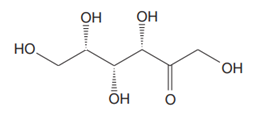
Explanation of Solution
The Lewis structure for fructose is

Fructose is a ketohexose with a molecular formula

The molecular formula for the above structure is
Ketohexose is a mono-saccharide having a carbonyl group at the internal carbon atom, and its molecular formula is
Want to see more full solutions like this?
Chapter 4 Solutions
EBK ORGANIC CHEMISTRY: PRINCIPLES AND M
- 14. Calculate the concentrations of Ag+, Ag(S2O3), and Ag(S2O3)23- in a solution prepared by mixing 150.0 mL of 1.00×10-3 M AgNO3 with 200.0 mL of 5.00 M Na2S2O3 Ag+ + S20 Ag(S203)¯ K₁ = 7.4 × 108 Ag(S203)¯ + S20¯ = Ag(S203) K₂ = 3.9 x 104arrow_forwardΗΝ, cyclohexanone pH 4-5 Draw Enamine I I CH3CH2Br THF, reflux H3O+ I Drawing Draw Iminium Ionarrow_forward:0: :0: Select to Add Arrows :0: (CH3)2NH :0: ■ Select to Add Arrows :0: :0: (CH3)2NH ■ Select to Add Arrowsarrow_forward
- Draw the product of the following H action sequence. Ignore any inorganic byproducts formed. 1. (CH3CH2)2CuLi, THF 2. CH3Br Q Atoms, Bonds and Rings H Charges ㅁarrow_forwardPlease help me with this the problem is so confusingarrow_forward14 Question (1 point) Disiamylborane adds to a triple bond to give an alkenylborane. Upon oxidation with OH, H2O2, the alkenylborane will form an enol that tautomerizes to an aldehyde. In the first box below, draw the mechanism arrows for the reaction of disiamylborane with the alkyne, and in the last box draw the structure of the aldehyde. 4th attempt Feedback i > 3rd attempt OH, H2O2 i See Periodic Table See Hintarrow_forward
- answer with mechanisms and steps. handwritten please!arrow_forwardHello I need some help with Smartwork. For drawing structure B, I know the correct answer is CH₃B₂, but when I try to type it in, it keeps giving me CH₄BH₃ instead. Do you know how I should write it properly? Should I use a bond or something else?arrow_forwardTrue or false, chemistryarrow_forward
- answer thse questions with mechanisms and steps. handwritten please!arrow_forwardC app.aktiv.com Draw the product of the following reaction sequence. Ignore any inorganic byproducts formed. H O 1. (CH3CH2)2CuLi, THF 2. CH3Br Drawingarrow_forwardDraw the product of the following reaction sequence. Ignore any inorganic byproducts formed. H O 1. (CH3CH2)2CuLi, THF 2. CHзBr Drawingarrow_forward
 Introductory Chemistry: An Active Learning Approa...ChemistryISBN:9781305079250Author:Mark S. Cracolice, Ed PetersPublisher:Cengage Learning
Introductory Chemistry: An Active Learning Approa...ChemistryISBN:9781305079250Author:Mark S. Cracolice, Ed PetersPublisher:Cengage Learning Organic Chemistry: A Guided InquiryChemistryISBN:9780618974122Author:Andrei StraumanisPublisher:Cengage Learning
Organic Chemistry: A Guided InquiryChemistryISBN:9780618974122Author:Andrei StraumanisPublisher:Cengage Learning Chemistry: Principles and PracticeChemistryISBN:9780534420123Author:Daniel L. Reger, Scott R. Goode, David W. Ball, Edward MercerPublisher:Cengage Learning
Chemistry: Principles and PracticeChemistryISBN:9780534420123Author:Daniel L. Reger, Scott R. Goode, David W. Ball, Edward MercerPublisher:Cengage Learning Chemistry for Today: General, Organic, and Bioche...ChemistryISBN:9781305960060Author:Spencer L. Seager, Michael R. Slabaugh, Maren S. HansenPublisher:Cengage Learning
Chemistry for Today: General, Organic, and Bioche...ChemistryISBN:9781305960060Author:Spencer L. Seager, Michael R. Slabaugh, Maren S. HansenPublisher:Cengage Learning World of Chemistry, 3rd editionChemistryISBN:9781133109655Author:Steven S. Zumdahl, Susan L. Zumdahl, Donald J. DeCostePublisher:Brooks / Cole / Cengage Learning
World of Chemistry, 3rd editionChemistryISBN:9781133109655Author:Steven S. Zumdahl, Susan L. Zumdahl, Donald J. DeCostePublisher:Brooks / Cole / Cengage Learning World of ChemistryChemistryISBN:9780618562763Author:Steven S. ZumdahlPublisher:Houghton Mifflin College Div
World of ChemistryChemistryISBN:9780618562763Author:Steven S. ZumdahlPublisher:Houghton Mifflin College Div





